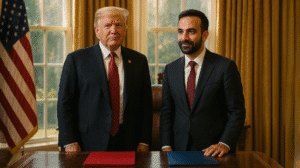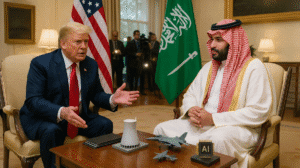The drone attack on the Conscience, a humanitarian vessel sailing under the Freedom Flotilla Coalition, has brought a new level of danger to activism aimed at breaking Israel’s blockade of Gaza. Struck in international waters off the coast of Malta on May 2, the ship suffered significant damage but, thankfully, no casualties. Yet beyond the wreckage lies a troubling pattern of militarized enforcement, strategic messaging, and the blurring of humanitarianism with terrorism.
At the center of the controversy is not only the attack itself, but the confirmed presence of an Israeli military aircraft over Malta’s airspace in the hours leading up to the strike. According to flight-tracking data from ADS-B Exchange, a Lockheed C-130 Hercules departed Israel on Thursday, flew west, and descended to a low altitude of roughly 5,000 feet over Malta. The aircraft loitered for about three hours, circling particularly over Hurd’s Bank, a shallow maritime zone frequented by shipping vessels east of the island. After seven hours in total, the C-130 returned to Israel.
While the C-130 is known globally as a transport aircraft, Israel’s use of this platform is more nuanced. Israel operates modified variants of the C-130, including the C-130H Karnaf, with capabilities that extend into special operations, aerial surveillance, and command-and-control support. Its low-altitude maneuvering and prolonged presence over Maltese airspace just hours before the drone strike cannot be dismissed as routine. Whether it was relaying communications, monitoring the flotilla, or coordinating the drone attack itself remains unknown, but the overlap raises difficult questions.
The Freedom Flotilla Coalition accused Israel of carrying out the strike, though Israel has neither confirmed nor denied involvement. Yet this is not the first time a flotilla bound for Gaza has faced forceful intervention. Previous missions have been intercepted by Israeli forces, sometimes violently, as was the case in 2010 when commandos boarded the Mavi Marmara, killing nine activists. Each attempt to breach the blockade tests not only Israeli policy but the world’s willingness to uphold or challenge it.
One of those planning to join the Conscience in Malta was Greta Thunberg, the Swedish climate activist who rose to global prominence as a teenager by confronting world leaders over their failure to address climate change. Her presence underscores the mission’s symbolic weight. “I was part of the group who was supposed to board that boat today to continue the voyage toward Gaza,” Thunberg said in a statement following the attack. “This is one of many attempts to open up a humanitarian corridor and to do our part to keep trying to break Israel’s illegal siege on Gaza.”
Also scheduled to board was retired U.S. Army Colonel Mary Ann Wright, a former diplomat and career military officer turned peace activist. Wright famously resigned from the State Department in protest over the 2003 invasion of Iraq and has since dedicated herself to anti-war activism and international human rights campaigns. Both Thunberg and Wright brought visibility and credibility to the flotilla’s mission, combining youth-led environmental advocacy with veteran peace activism in a shared call for humanitarian relief.
Critics, however, have seized on the mission as yet another example of what they claim is a blurred line between pro-Palestinian activism and support for Hamas, the governing authority in Gaza that is designated as a terrorist organization by Israel, the United States, and the European Union. This conflation has become a powerful narrative tool, framing any challenge to the blockade not as a humanitarian gesture but as a potential security threat. By painting activists and aid convoys as complicit with Hamas, defenders of the blockade argue that enforcement actions—even military strikes far from Israeli waters—are justified in the name of counterterrorism.
It is this framing that poses perhaps the most insidious danger. When activists delivering food, medicine, and water are branded as collaborators with terrorism, the space for legitimate humanitarian action shrinks. Public discourse becomes skewed, political leaders feel pressured to distance themselves from aid missions, and military interventions escape scrutiny under the convenient banner of national security.
Meanwhile, the human suffering in Gaza deepens. On the same day as the attack, the United Nations issued dire warnings that food supplies in Gaza had “mainly run out.” Community kitchens were closing. Hospitals were running out of blood and electricity. UN humanitarian spokesperson Olga Cherevko described scenes of desperation where people were “killing each other over water” as aid trucks arrived. The International Committee of the Red Cross declared the humanitarian response in Gaza “on the verge of total collapse.”
Against this backdrop, the strike on the Conscience reads less as an isolated act and more as an extension of a blockade policy enforced not only through naval patrols but increasingly through remote and extraterritorial means. The drone attack—executed outside Maltese territorial waters, but close enough to require Maltese intervention—demonstrates the long arm of Israeli defense policy. That a military aircraft circled Malta hours before the attack further complicates the picture, suggesting not only surveillance but possibly airborne coordination of assets well beyond Israel’s borders.
Some may argue that such preemptive measures are necessary to prevent weapons smuggling or material aid to Hamas. Yet the flotilla’s organizers have consistently maintained transparency about their cargo, inviting inspections and documenting their efforts. No evidence has emerged linking the Conscience or its passengers to weapons or militant activity. The attack therefore raises profound ethical and legal questions about proportionality, sovereignty, and the criminalization of humanitarian solidarity.
For Thunberg and Wright, the attack represents both a setback and a grim validation of their cause. By targeting a ship carrying medical supplies and international activists, the strike exposed the lengths to which a military will go to maintain a siege—even at the cost of diplomatic friction with European states like Malta, whose airspace and maritime zones were effectively surveilled without consent.
The attack on the Conscience should force a reckoning over more than just Israeli policy. It should challenge how Western governments and media perpetuate the narrative that pro-Palestinian activism equals support for terrorism. It should prompt reflection on the growing militarization of humanitarian aid routes, and the shrinking space for civil society to intervene in crises like Gaza without becoming targets themselves.
Most of all, it should remind us that as long as people like Thunberg and Wright are willing to risk their safety for the principle that no people should be starved into submission, no amount of drones or disinformation will erase the moral clarity of their mission.


















